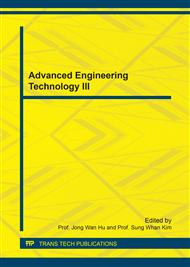[1]
E. Hoek, Keynote address: tunnel support in weak rock. In: Proceedings of the Symposium of Sedimentary Rock Engineering, Taipei, Taiwan, (1998) 1-12.
Google Scholar
[2]
D. MašÍN, 3D Modeling of an NATM Tunnel in High K[sub 0] Clay Using Two Different Constitutive Models, J. Geotech. Geoenvironm. Eng. 135(9) (2009) 1326-1335.
DOI: 10.1061/(asce)gt.1943-5606.0000017
Google Scholar
[3]
J. Lee, S. Akutagawa, Y. Yokota, et al. Estimation of model parameters and ground movement in shallow NATM tunnel by means of neural network, Tunnelling Undergr. Space Technol. 21(3-4) (2006) 242.
DOI: 10.1016/j.tust.2005.12.020
Google Scholar
[4]
T. Fulvio, Sequential excavation, NATM and ADECO: What they have in common and how they differ, Tunnelling Undergr. Space Technol. 25(3) (2010) 245-265.
DOI: 10.1016/j.tust.2009.12.004
Google Scholar
[5]
M. M. D. Farias, A. P. D. Assis, Displacement control in tunnels excavated by the NATM: 3-D numerical simulations, Tunnelling Undergr. Space Technol. 19(3) (2004) 283-293.
DOI: 10.1016/j.tust.2003.11.006
Google Scholar
[6]
R. Schwingenschloegl, C. Lehmann, Swelling rock behaviour in a tunnel: NATM-support vs. Q-support – A comparison, Tunnelling Undergr. Space Technol. 24(3) (2009) 356-362.
DOI: 10.1016/j.tust.2008.08.007
Google Scholar
[7]
D. Boldini, R. Lackner, H. A. Mang, Ground-Shotcrete Interaction of NATM Tunnels with High Overburden, J. Geotech. Geoenvironm. Eng. 131(7) (2005) 886-897.
DOI: 10.1061/(asce)1090-0241(2005)131:7(886)
Google Scholar
[8]
J. H. Shin, D. M. Potts, Time-based two dimensional modelling of NATM tunneling, Can. Geotech. J. 39(3) (2002) 710-724.
DOI: 10.1139/t02-009
Google Scholar
[9]
C. W. Ng, K. M. Lee, D. K. Tang, Three-dimensional numerical investigations of new Austrian tunneling, Can. Geotech. J. 41(3) (2004) 523-539.
DOI: 10.1139/t04-008
Google Scholar
[10]
E. Hoek, E. T. Brown, Empirical strength criterion for rock masses, J. Geotech. Eng. Divis. 106(15715) (1980) 1013-1035.
DOI: 10.1061/ajgeb6.0001029
Google Scholar
[11]
E. Hoek, D. Wood, S. Shah, A modified Hoek-Brown criterion for jointed rock masses. Proc. Rock Characterization, Symp. Int. Soc. Rock Mech.: Eurock '92, London, (1992) 209-214.
DOI: 10.1007/s00603-021-02661-2
Google Scholar
[12]
E. Hoek, C. Carranza-Torres, B. Corkum, Hoek–Brown failure criterion—2002 edition. In: R. Hammah, W. Bawden, J. Curran, M. Telesnicki editors, Proceedings of the Fifth North American Rock Mechanics Symposium and 17th Tunnelling Association of Canada Conference: NARMS-TAC, vol. 1, Toronto. Toronto: University of Toronto Press; (2002).
Google Scholar
[13]
Rocsicence Inc., 2008. Support Version 3. 002- Rock support interaction and deformation analysis for tunnels in weak rock. www. Rocscience. com. Toronto, Ontario, Canada.
Google Scholar


